Best laptops under Rs 60,000
Under ₹60,000, choose between Intel H-series Core i7 powerhouses or RTX 3050-equipped rigs for smooth gaming and creative tasks.
With 16 GB RAM, PCIe 4.0 SSDs, crisp 15.6-inch Full HD IPS panels, these laptops handle multitasking, rendering and playback effortlessly.
Battery packs up to ~70 Wh and fast USB-C charging deliver all-day productivity without hunting for outlets.
From sub-1.3 kg fanless MacBook Air to 2 kg RTX-equipped workhorses, there’s a model for every portability-power balance.
This guide breaks down CPU, GPU, display and battery specs, helping you pick the perfect under-₹60,000 laptop for your needs.
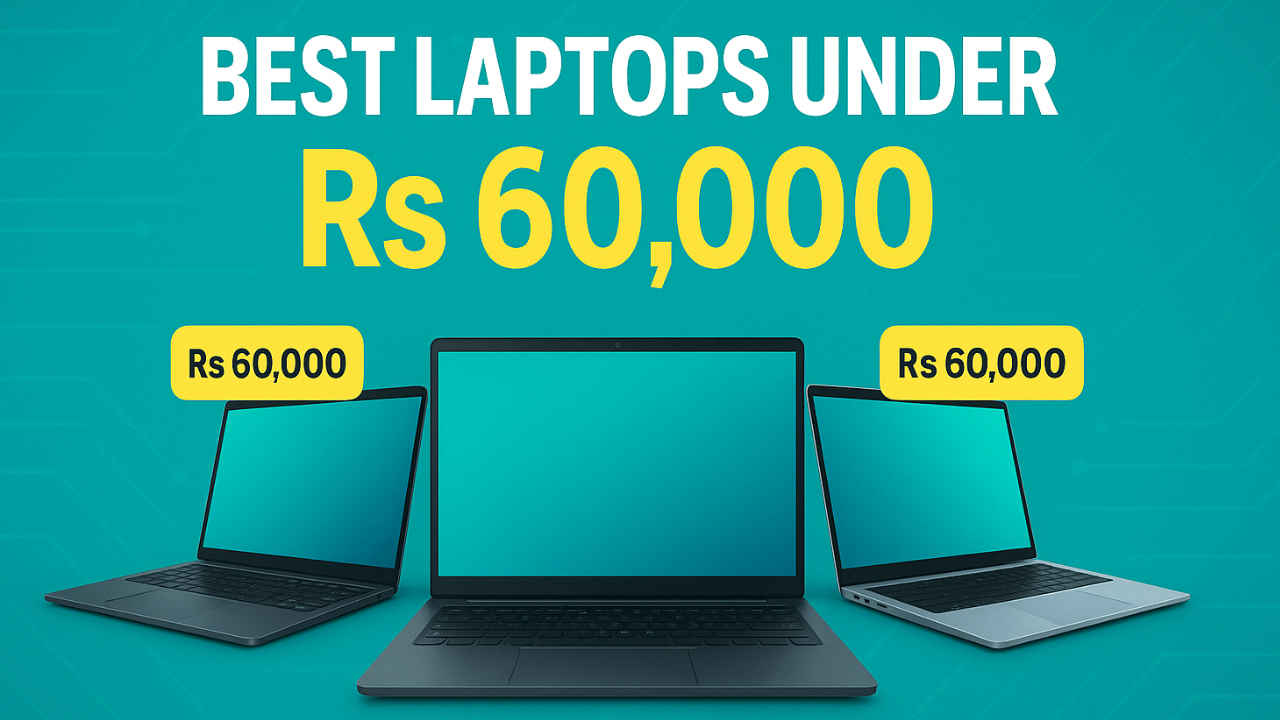
When you have ₹60,000 to spend on a laptop, let me assure you that you have a good budget and you can either get a laptop with a discrete GPU or a CPU that can handle all the basic + some creative tasks like rendering, compilations, etc., efficiently. To do justice to your budget, we have handpicked one of the best laptops available under 60,000 with a sturdy finish, powerful specs, and future proofing as well.
 Survey
SurveyLenovo IdeaPad Slim 3 – ₹62,990
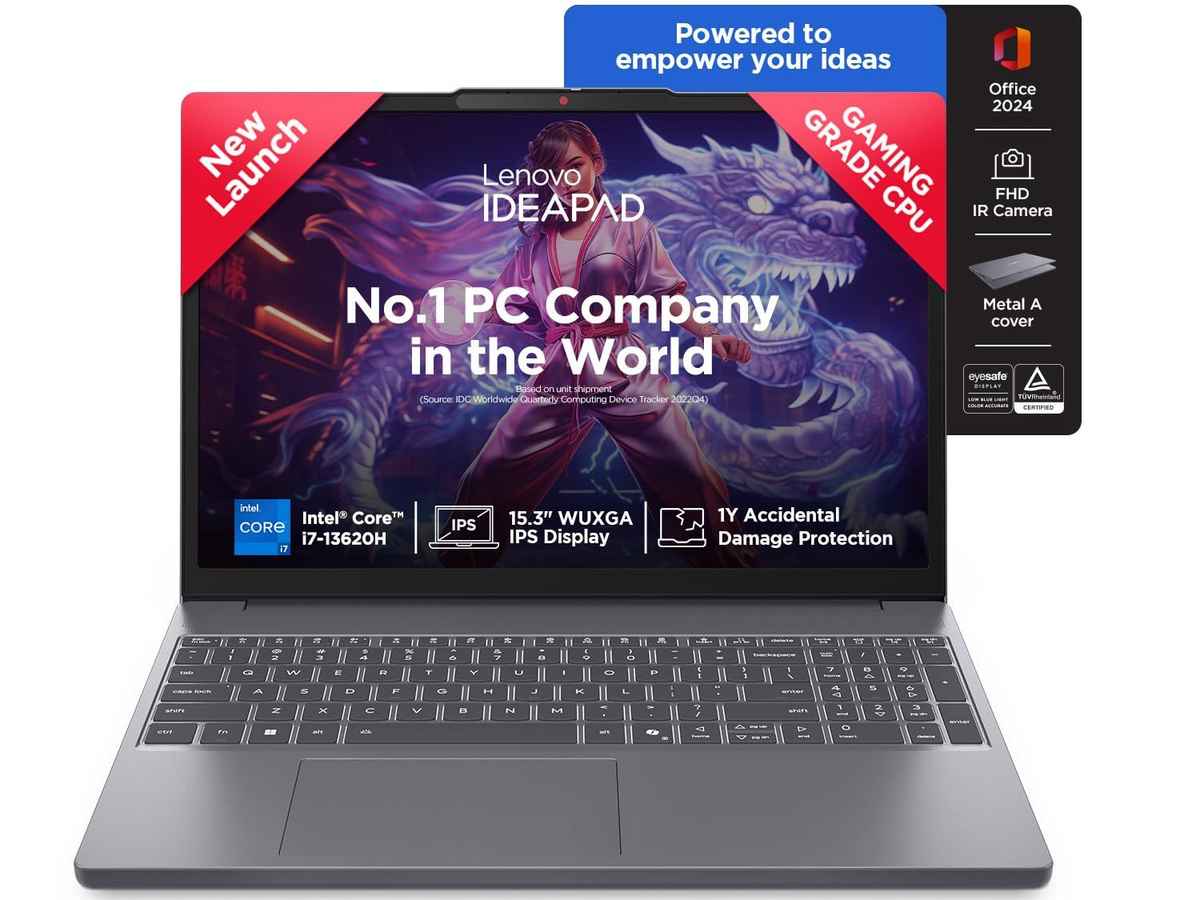
Lenovo’s IdeaPad Slim 3 brings desktop-class punch to a thin-and-light 1.7 kg chassis by pairing Intel’s 13th-Gen Core i7-13620H (10-cores, 16-threads, turbo to 4.9 GHz) with 16 GB LPDDR5-4800 memory and a 512 GB PCIe SSD. The 15.6-inch Full-HD IPS panel delivers 300 nits brightness, an anti-glare coating, and Dolby-tuned stereo speakers for crisp Netflix marathons after work. A 47 Wh battery targets roughly five hours on Wi-Fi and recharges via the bundled 65 W adaptor, while the twin-heat-pipe cooling keeps the H-series chip quiet in libraries. Connectivity is generous: one USB-C 3.2 Gen 1 with Power-Delivery and DisplayPort 1.2, two USB-A 5 Gbps, HDMI 1.4b, a combo audio jack, plus Wi-Fi 6 and Bluetooth 5.2 for lag-free Zoom calls. Finishing touches such as a 1080p webcam with privacy shutter, a back-lit keyboard, and MIL-STD-rated Arctic-grey shell make this ₹ 62,990 notebook a balanced choice for students and professionals alike.
| Specification | Details |
| Price | ₹62,990, user-specified launch offer |
| Processor | Intel Core i7-13620H, 6 P-cores, 4 E-cores, 16 threads, 2.4–4.9 GHz turbo, 24 MB cache |
| Graphics | Intel UHD Graphics, integrated |
| Memory | 16 GB LPDDR5-4800 |
| Storage | 512 GB PCIe NVMe SSD |
| Display | 15.6 in, 1920 × 1080, IPS, 300 nits brightness, anti-glare |
| Battery & charging | 47 Wh Li-ion, ≈5 h mixed use |
| Ports | USB-C 3.2 Gen 1 (PD, DP 1.2), 2 × USB-A 3.2 Gen 1, HDMI 1.4b, 3.5 mm audio |
| Weight | 1.7 kg |
Who should buy this laptop: Power users who crunch large spreadsheets, edit photos, or code in multiple IDEs will welcome the H-series CPU and 16 GB RAM. Commuters who want a full-size screen without lugging more than 1.7 kg get solid battery life, USB-C charging, and a privacy webcam. Small-business owners needing rapid charging, Wi-Fi 6, and robust build quality at roughly ₹63k should shortlist the IdeaPad Slim 3.
MSI Thin A15 – ₹59,990
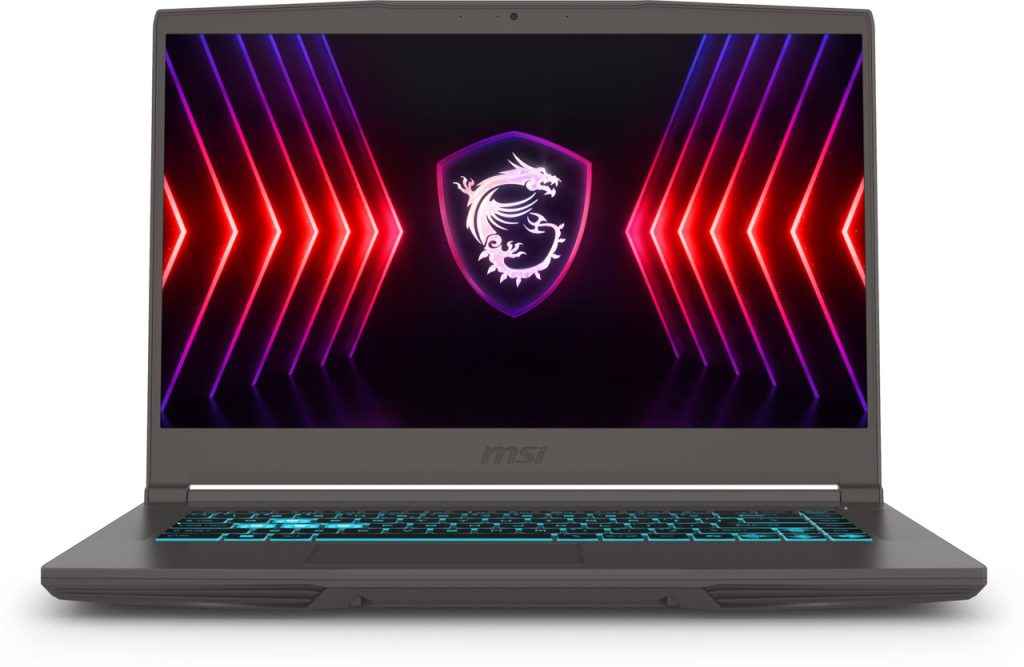
MSI’s Thin A15 packs desktop-style horsepower into a 1.86 kg, 21.7 mm chassis: AMD’s Ryzen 5 7535HS delivers 6 Zen 3 Plus cores and 12 threads that turbo to 4.55 GHz for fast compile times and smooth 1080p gaming, while NVIDIA’s GeForce RTX 3050 (4 GB GDDR6) pairs with a 144 Hz, 15.6 in IPS-level display so esports titles sail past triple-digit frames. 16 GB DDR5-4800 RAM and a 512 GB PCIe 4.0 SSD keep Windows snappy and leave headroom for large Steam libraries. Cooling uses dual fans and heat pipes to tame the 105 W combined CPU–GPU load. A 52.4 Wh 3-cell battery lasts around 4 – 5 h of mixed browsing and recharges through the USB-C port, which also handles DisplayPort and up to 100 W Power Delivery. Connectivity covers Wi-Fi 6E, Bluetooth 5.3, HDMI 2.1 (8K 60 Hz or 4K 120 Hz), one USB-C 3.2 Gen 2, and three USB-A 3.2 Gen 1, so plugging in fast external SSDs and an extra monitor is simple. A single-colour blue back-lit keyboard, 720p webcam, and two-year onsite warranty round out a well-equipped machine that hits the sweet spot between budget and performance at ₹ 59,990.
Also read: Best laptops for design and animation students
| Specification | Details |
| Price | ₹59,990 |
| Processor | Ryzen 5 7535HS, 6 cores (2 P, 4 E), 12 threads, 3.3 GHz base, 4.55 GHz turbo, 45 W TDP |
| Graphics | GeForce RTX 3050, 4 GB GDDR6, Ray-tracing, DLSS 2 |
| Memory | 16 GB DDR5-4800, dual-channel, 2 slots, upgradable to 64 GB |
| Storage | 512 GB PCIe 4.0 NVMe SSD, free M.2 slot |
| Display | 15.6 in, 1920 × 1080, IPS-level, 144 Hz, 45% NTSC |
| Battery & charging | 52.4 Wh 3-cell, ≈ 4–5 h mixed use, USB-C PD up to 100 W |
| Ports | USB-C Gen 2 (PD, DP), 3 × USB-A Gen 1, HDMI 2.1, RJ-45, 3.5 mm combo jack |
| Weight | 1.86 kg |
Who should buy this laptop: Gamers who play competitive shooters at high frame rates and want RTX ray-tracing under ₹ 60,000 will love the 144 Hz panel and RTX 3050 horsepower. Content-creation students needing CPU multithread grunt and DDR5 memory get balanced performance without heavy bulk. Travellers seeking a full gaming rig that still slips into a backpack benefit from the 1.86 kg weight, Wi-Fi 6E, and USB-C charging versatility.
MacBook Air M1 – ₹59,990
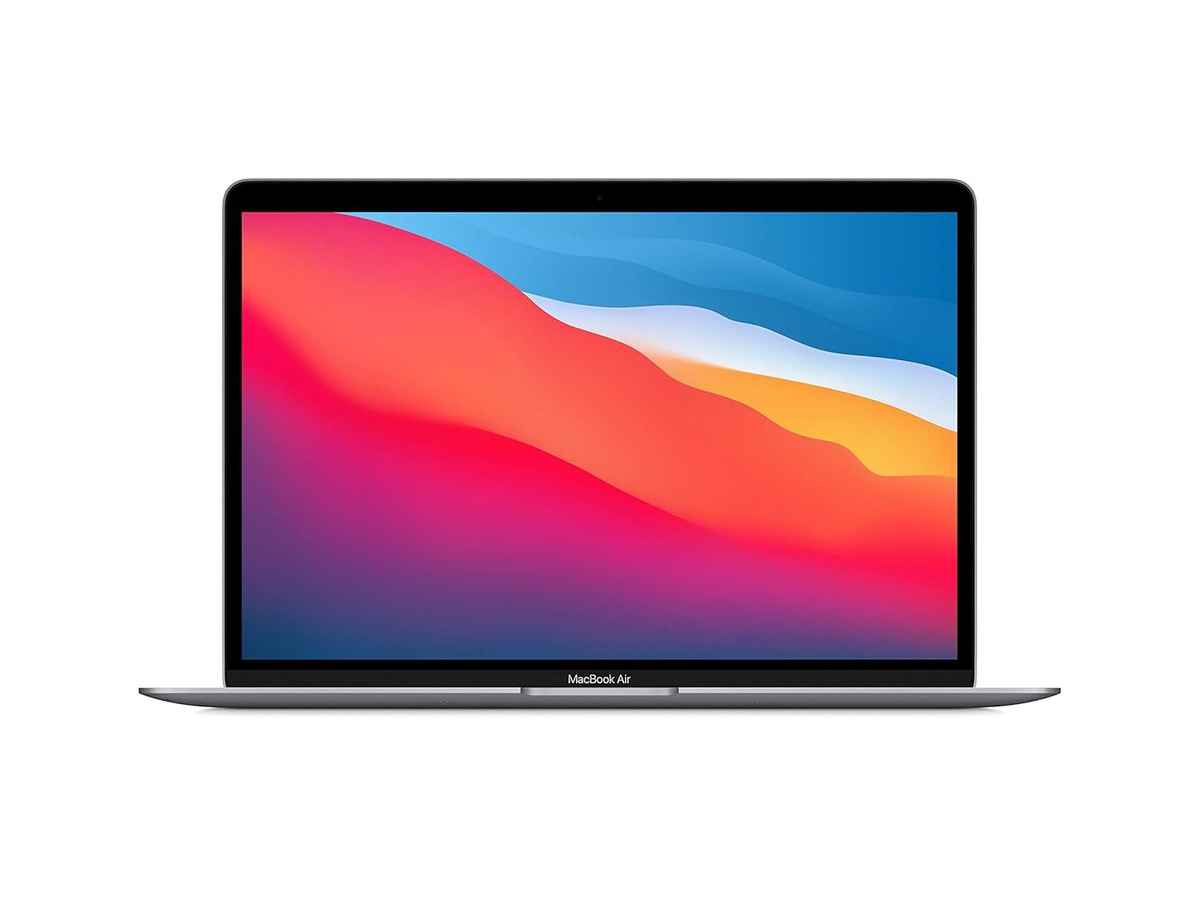
Apple’s fan-less MacBook Air M1 gives you desktop-class speed in a 1.29 kg shell: an 8-core M1 chip with a 7-core GPU and 16-core Neural Engine opens large Keynote decks, edits photos and streams 4K video without a whisper, yet its 49.9 Wh battery lasts up to 15 h of web work or 18 h of films so you can leave the charger at home. The 13.3 in 2560 × 1600 Retina IPS screen hits about 400 nits and covers the P3 gamut, making colours pop for creatives and binge-watchers alike. You get 8 GB unified memory that shares bandwidth across CPU and GPU, plus a 256 GB NVMe SSD that wakes macOS in under seconds. Two Thunderbolt 3/USB-4 ports drive a 6 K external display and fast SSD enclosures, while Wi-Fi 6 and Bluetooth 5.0 keep wireless links solid in busy cafés. Touch ID, Magic Keyboard, Force Touch trackpad, and a 720p webcam with neural noise reduction add polish, all wrapped in a 16.1 mm recycled-aluminium body that stays cool on your lap. At ₹ 59,990, it is still the quietest, longest-lasting way to run Logic, Xcode, or a day’s worth of browser tabs on the move.
Also read: Don’t Buy Apple MacBook Accessories Before You See These Cheaper Alternatives
| Specification | Details |
| Price | ₹59,990 |
| Processor | Apple M1, 8-core CPU (4 performance, 4 efficiency), 3.2 GHz boost |
| Graphics & NPU | 7-core GPU, 16-core Neural Engine |
| Memory | 8 GB unified LPDDR4X-4266 |
| Storage | 256 GB PCIe NVMe SSD |
| Display | 13.3 in, 2560 × 1600, IPS, 400 nits, P3 colour, 16:10 ratio |
| Battery & life | 49.9 Wh Li-ion, ≈15 h web, 18 h video, 30 W USB-C charger |
| Ports | 2 × Thunderbolt 3/USB-4, 3.5 mm audio |
| Weight | 1.29 kg |
Who should buy this laptop: Mobile professionals who need silent power, all-day battery life, and a colour-accurate screen will find the Air ideal. Students who juggle coding, note-taking, and streaming can carry 1.3 kg and still get a full day of classes on one charge. First-time Mac buyers wanting pro-level performance, Thunderbolt speed, and premium build for under ₹60,000 should start here.
ASUS’s Vivobook 16X – ₹59,990
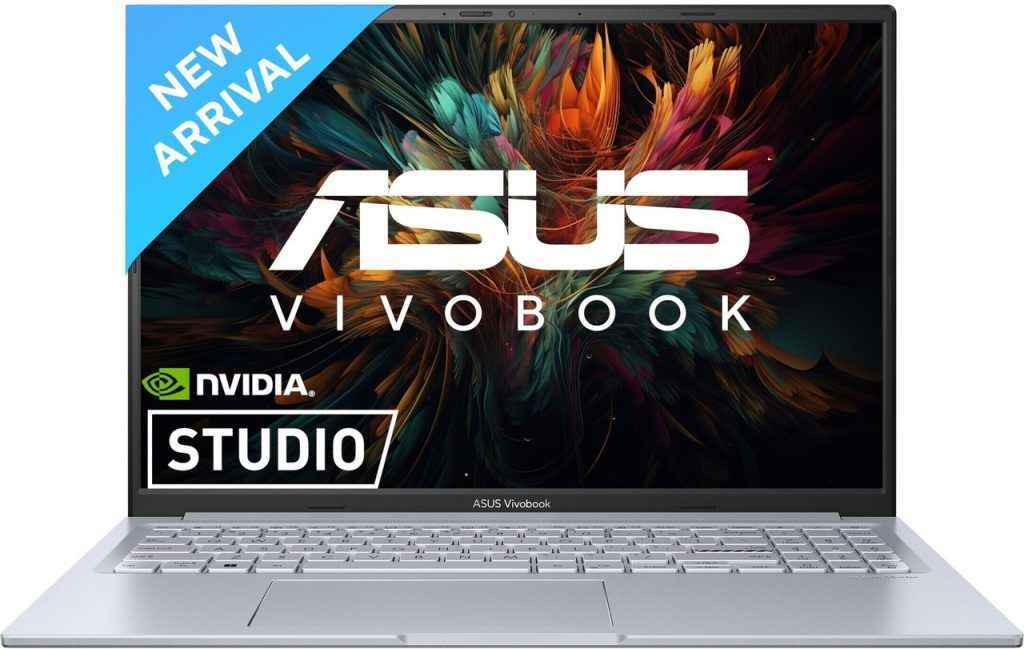
ASUS’s Vivobook 16X K3605ZF squeezes Intel’s 12-core/16-thread Core i5-12500H (boost 4.5 GHz) and an NVIDIA GeForce RTX 2050 4 GB into a 1.8 kg metal shell that is just 21 mm thin, then tops it with a 16-in WUXGA 1920 × 1200 IPS panel running at 144 Hz for fluid esports or colour-accurate creation work. 16GB DDR5-4800 memory and a 512 GB PCIe 4.0 SSD keep large Adobe projects or Steam libraries snappy, with an empty M.2 slot for future expansion. Cooling relies on twin fans and heat-pipes tuned by MSI’s Silent profile to stay library-quiet during light tasks yet unleash up to 90 W combined CPU–GPU power when you render or game. A 50 Wh battery is rated for about 8 h of mixed work and tops up via the USB-C port that also carries DisplayPort signalling and 100 W Power-Delivery. I/O is creator-friendly: one USB-C 10 Gbps, two USB-A 5 Gbps, a USB-A 2.0 for a mouse, HDMI 2.1 for up-to-8 K output, Wi-Fi 6E and Bluetooth 5.3.Extras such as a back-lit numeric keyboard, 720 p webcam with privacy shutter and MIL-STD-tested chassis round off a surprisingly well-equipped laptop at ₹59,990.
| Specification | Details |
| Price | ₹59,990 |
| Processor | Core i5-12500H, 12 cores (4 P, 8 E), 16 threads, 4.5 GHz turbo |
| Graphics | GeForce RTX 2050, 4 GB GDDR6 |
| Memory | 16 GB DDR5-4800, dual-channel, upgradable to 64 GB |
| Storage | 512 GB PCIe 4.0 NVMe SSD, spare M.2 slot |
| Display | 16-inch, 1920×1200, 16:10, IPS-level, 144 Hz, 300 nits, 45% NTSC |
| Battery & life | 50 Wh 3-cell, ≈ 8 h mixed use, 100 W USB-C PD |
| Ports | USB-C PD 10 Gbps, 2 × USB-A 5 Gbps, USB-A 2.0, HDMI 2.1, audio jack, |
| Weight | 1.8 kg |
Who should buy this laptop: Content creators juggling Lightroom and Premiere benefit from the 16 : 10 screen, 16 GB RAM, and upgrade-ready storage. Students or mobile professionals seeking a full-size yet portable machine with USB-C charging and sturdy build should shortlist the Vivobook 16X.
Acer’s Swift Go 14 – ₹54,990
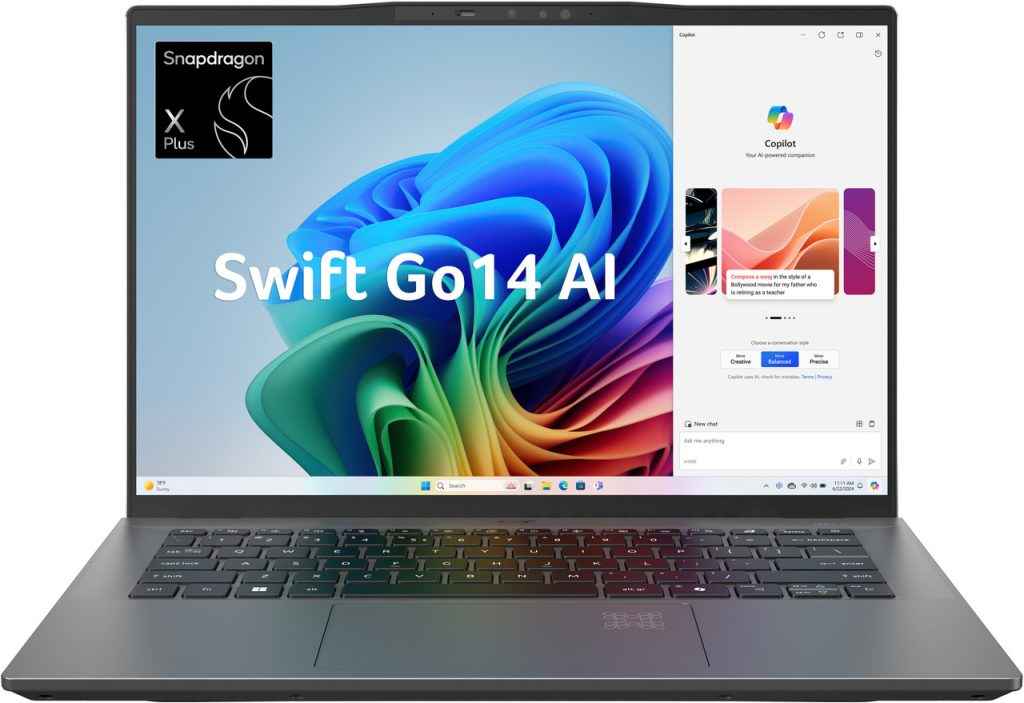
Acer’s Swift Go 14 makes the new Copilot-ready Snapdragon platform truly affordable at ₹54,990: its Snapdragon X Plus X1P-42-100 octa-core chip (3.2 GHz boost) pairs with 16 GB LPDDR5X RAM and a 512 GB PCIe 4.0 SSD, so Windows 11 on ARM feels brisk while staying whisper-quiet thanks to the fan-less design. The 14.5 in WUXGA IPS display (1920×1200, 16∶10) runs at 120 Hz for smoother scrolling, yet the all-metal chassis weighs only 1.32 kg and measures 17.95 mm slim. Acer quotes up to 28 h battery life from the high-efficiency SoC, and in a detailed review by Notebookcheck, mentioned that the Swift Go was able to deliver 24 hours of playback, meaning a full day away from mains. Wi-Fi 7 and Bluetooth 5.3 future-proof connectivity, while a back-lit Copilot keyboard, QHD webcam with temporal noise reduction, and trio of USB (including a Type-C port that handles charging and DisplayPort) round out a travel-friendly package that undercuts many Intel and AMD rivals.
Also read: Best laptops for machine learning in 2025
| Specification | Details |
| Price | ₹54 990 special price |
| Processor | Snapdragon X Plus X1P-42-100, 8 cores, 3.2 GHz boost, on-chip NPU 45 TOPS |
| Graphics | Qualcomm Adreno integrated GPU |
| Memory | 16 GB LPDDR5X-8533, dual-channel, soldered |
| Storage | 512 GB PCIe 4.0 NVMe SSD |
| Display | 14.5-inch, 1920×1200, IPS, 120 Hz, 300 nits, 16∶10, ComfyView anti-glare |
| Battery & life | 65 Wh Li-ion, rated ≤ 28 h video |
| Ports | USB-C 3.2 Gen 1 (PD, DP), USB-A 3.2 Gen 1 with power-off charge, USB-A 3.2 Gen 1, HDMI 1.4, 3.5 mm audio |
| Weight | 1.32 kg, steel-grey aluminium shell |
Who should buy this laptop: Road-warrior students and executives who crave all-day battery life, Wi-Fi 7 speed, and a high-refresh 16:10 screen in a 1.3 kg bag will love the Swift Go 14. Developers or content creators testing ARM builds get a fast NPU and plenty of memory without blowing the budget. Early adopters seeking a thin, silent machine with Copilot-plus features and long support at under ₹55,000 should put this Acer high on their shortlist.
Infinix’s ZeroBook 13 – ₹58,990
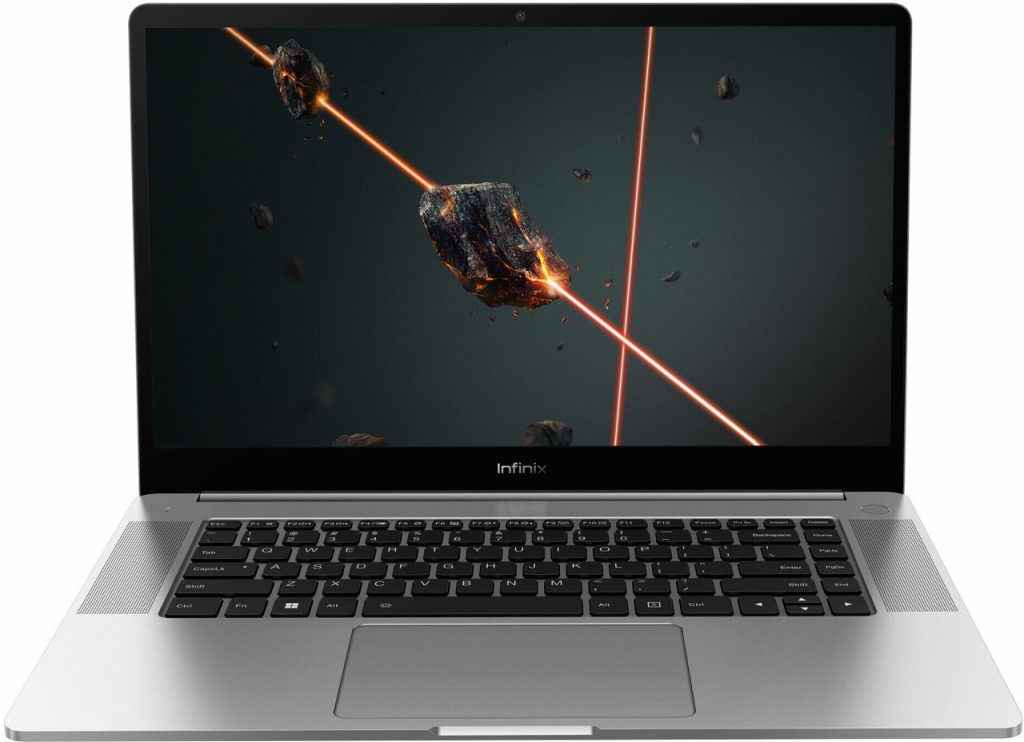
Infinix’s ZeroBook 13 offers genuine flagship firepower at ₹58,990: its Core i9-13900H wields 14 cores and 20 threads that peak at 5.4 GHz, backed by 32 GB LPDDR5X RAM and a 1 TB PCIe 4.0 SSD for workstation-class throughput. The 1.8 kg, 16.9 mm, all-metal shell stays cool thanks to the dual-fan Ice Storm 2.0 system, and a side-mounted Overboost switch can unlock a sustained 54 W CPU ceiling for bursts of compiling or rendering. It’s a 15.6-inch IPS display that hits 1920×1080, 400 nits, and 100% sRGB, so colours remain faithful when grading footage, while a 70 Wh battery with a 100 W Hyper-Charge brick delivers up to 10h of web work and recharges fully in about two hours. Wi-Fi 6E, two USB-C, two USB 3.0, HDMI 1.4, an SD card slot, and a fingerprint reader sit alongside an AI-enhanced 1080p webcam and quad speakers, making the ZeroBook 13 a well-rounded creator and power-user machine at an unusually low price.
| Specification | Details |
| Price | ₹58,990 special price |
| Processor | Core i9-13900H, 14 cores (6 P, 8 E), 20 threads, 5.4 GHz turbo |
| Memory | 32 GB LPDDR5X-8533, dual-channel, soldered |
| Storage | 1 TB PCIe 4.0 SSD, dual slots allow up to 2 TB |
| Display | 15.6-inch, 1920×1080, IPS, 400 nits, 100% sRGB, 72% NTSC |
| Graphics | Intel Iris Xe 96 EU integrated GPU |
| Battery & charging | 70 Wh lithium-ion, ≈10 h web, 100 W USB-C Hyper-Charge |
| Cooling | Ice Storm 2 .0 dual-fan, 65 mm fans, 0.25 mm shark-fin blades |
| Overboost switch | Three modes: Eco, Balanced, Overboost (54 W output) |
| Ports | 2 × USB-C (1 PD), 2 × USB 3.0, HDMI 1.4, SD card, 3.5 mm audio |
| Wireless | Wi-Fi 6E tri-band, Bluetooth 5.2 |
| Weight | 1.8 kg metal body |
Who should buy this laptop: Power users who crunch code, layer timelines, or virtualise OSes will relish the i9, 32 GB RAM, and Overboost head-room. Creators needing a colour-accurate 400-nit screen, fast PCIe 4.0 storage, and an SD slot get a capable mobile studio for under ₹60,000. Tech enthusiasts wanting big-core performance, Wi-Fi 6E, and 100 W USB-C charging in a slim metal shell at a bargain price should shortlist the ZeroBook 13.
Colourful XS 15 – ₹51,990
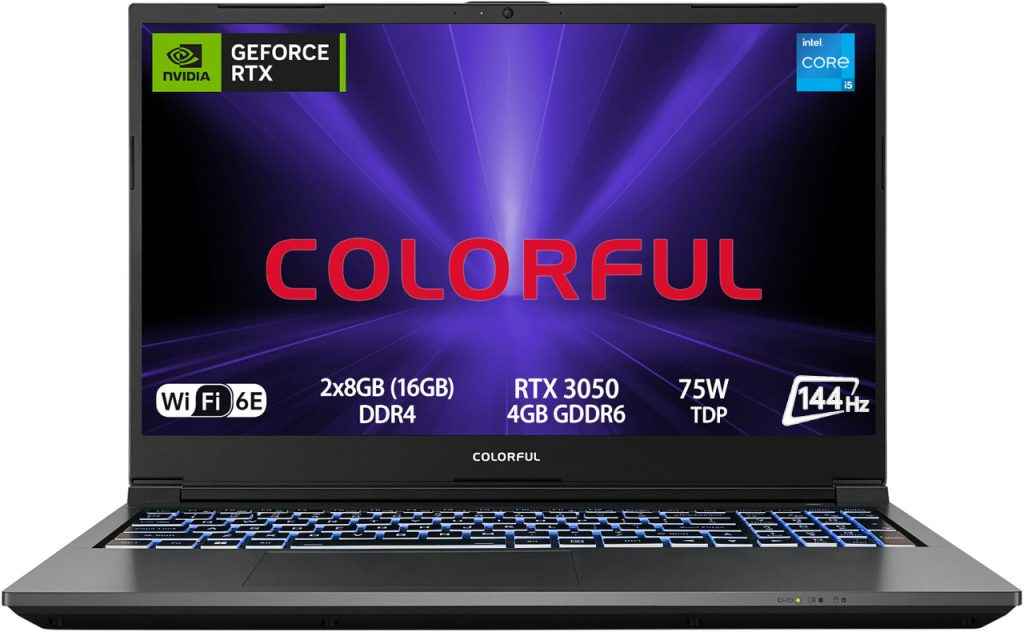
Colourful’s XS 15 gaming laptop squeezes a 12-core/16-thread Core i5-12500H (2.5–4.5 GHz) and an RTX 3050 running at a healthy 75 W TGP into a 1.99 kg, 22.7 mm chassis, then cools the lot with Storm Blade dual-fan thermals and a Fn + 1 Turbo switch that unlocks three power profiles. A 15.6-in full-HD panel refreshes at 144 Hz for butter-smooth esports, while 16 GB DDR4 RAM and a 512 GB NVMe SSD keep Windows and game loads quick. I/O covers USB-C data, two USB 3.2 Gen 2 ports, one USB 3.2 Gen 1, a USB 2.0 for mouse dongles, and HDMI for an external display, though the Type-C lacks display-out or charging. A 4-cell battery promises about three hours of unplugged browsing, and the illuminated keyboard rounds things off for late-night sessions.
| Specification | Details |
| Price | ₹51,990 |
| Processor | Core i5-12500H, 12 cores (4 P, 8 E), 16 threads, 2.5, 4.5 GHz turbo |
| Graphics | GeForce RTX 3050, 4 GB GDDR6, 75 W TGP |
| Memory | 16 GB DDR4-3200 |
| Storage | 512 GB PCIe NVMe SSD |
| Display | 15.6-inch, 1920 × 1080, LCD, 144 Hz, anti-glare |
| Battery & life | 4-cell pack, up to 3 h mixed use |
| Ports | USB-C (data), 2 × USB 3.2 Gen 2, USB 3.2 Gen 1, USB 2.0, HDMI, combo audio jack |
| Weight | 1.99 kg |
Who should buy this laptop: Competitive gamers seeking 144 Hz RTX performance on a lean budget will find excellent value. Creators who need CUDA acceleration for editing yet want a portable 2 kg build get balanced power.
Which laptop should you buy?
Need ultra-high CPU grunt for code compiles, data science, or 4K timelines? Pick the Infinix ZeroBook 13 with its 14-core Core i9-13900H, 32 GB RAM, and 1 TB SSD, easily the fastest chip–memory combo here yet still under ₹60,000. If your priority is a large 16:10 canvas and discrete RTX graphics for Blender, Lightroom, or weekend gaming, the ASUS Vivobook 16X pairs a 16-inch 144 Hz panel with an RTX 2050 and 16 GB DDR5, giving the best creator-gamer balance in this price band.
Competitive gamers on a tighter budget should eye the Colorful XS Series: its RTX 3050 at 75 W TGP beats the Vivobook’s GPU and costs almost ₹ 8,000 less, making it the value pick for pure frame rates. For a thinner chassis without sacrificing RTX power, MSI’s Thin A15 keeps weight to 1.86 kg while the Ryzen 5 7535HS and RTX 3050 handle 1080 p esports smoothly, perfect for students who game after class. Road warriors who need marathon battery life and the newest on-device AI features should shortlist the fan-less Acer Swift Go 14 Snapdragon X Plus; real-world tests still deliver 15 – 18 h unplugged and Wi-Fi 7 future-proofs connectivity.
If silent operation, class-leading endurance and macOS are must-haves, the Apple MacBook Air M1 remains unrivalled with up to 15 h web use in a 1.29 kg shell. Finally, users who want strong multithread CPU punch for heavy spreadsheets but can live with integrated graphics will be well served by the Lenovo IdeaPad Slim 3 and its Core i7-13620H, which also carries a MIL-tested chassis and Rapid-Charge support for office life on the move.
Sagar Sharma
A software engineer who happens to love testing computers and sometimes they crash. While reviving his crashed system, you can find him reading literature, manga, or watering plants. View Full Profile